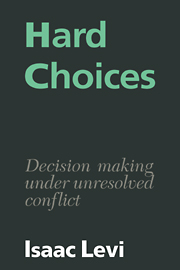Book contents
- Frontmatter
- Contents
- Preface
- 1 MORAL STRUGGLE
- 2 DILEMMAS
- 3 VALUES IN SCIENTIFIC INQUIRY
- 4 CHOICE AND FOREKNOWLEDGE
- 5 VALUE STRUCTURES
- 6 VALUES REVEALED BY CHOICES
- 7 UNCERTAINTY AS A SOURCE OF CONFLICT
- 8 CONFLICT AND SOCIAL AGENCY
- 9 DISTRIBUTING BENEFITS
- 10 UTILITARIANISM AND CONFLICT
- 11 SOCIAL CHOICE THEORY
- 12 CONFLICT AND INQUIRY
- Notes
- Bibiliography
- Name index
- Subject index
6 - VALUES REVEALED BY CHOICES
Published online by Cambridge University Press: 05 June 2012
- Frontmatter
- Contents
- Preface
- 1 MORAL STRUGGLE
- 2 DILEMMAS
- 3 VALUES IN SCIENTIFIC INQUIRY
- 4 CHOICE AND FOREKNOWLEDGE
- 5 VALUE STRUCTURES
- 6 VALUES REVEALED BY CHOICES
- 7 UNCERTAINTY AS A SOURCE OF CONFLICT
- 8 CONFLICT AND SOCIAL AGENCY
- 9 DISTRIBUTING BENEFITS
- 10 UTILITARIANISM AND CONFLICT
- 11 SOCIAL CHOICE THEORY
- 12 CONFLICT AND INQUIRY
- Notes
- Bibiliography
- Name index
- Subject index
Summary
Choice and preference
An agent choosing between options x and y in a state of unresolved conflict might recognize as permissible three distinct value rankings: x better than y, x equal in value to y and y better than x. If the agent's value structure did acknowledge the permissibility of all three rankings, both x and y would be V1-admissible, and if there were no secondary or still higher level value structure, both options would be admissible.
This way of describing the agent's predicament may seem misleading. According to a widely held opinion, if both options are admissible for the agent, he should be considered indifferent between them and both options counted as optimal for him. What in my accounting is regarded as unresolved conflict is nothing more than a situation where two options are best.
Suppose, however, that, in the way of speaking I have been using, the agent has a secondary value structure. Although both x and y are, as before, V1-admissible, x is rated over y according to the secondary structure and, hence, is uniquely admissible. Here too it may seem that what I consider to be a decision problem under unresolved conflict is better seen as a choice situation where the agent ranks x over y and x is counted as uniquely optimal.
According to this rival way of describing matters, an agent's rating of alternatives is determined by how he would choose between any given pair of options or by determining for each pair which is and which is not admissible for the agent.
- Type
- Chapter
- Information
- Hard ChoicesDecision Making under Unresolved Conflict, pp. 83 - 107Publisher: Cambridge University PressPrint publication year: 1986



